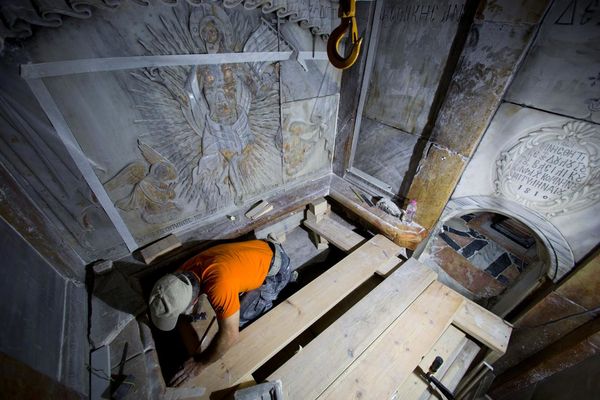A shocking discovery was made by the officials of the National Technical University of Athens, which is presented by National Geographic and confirms that the Tomb of Jesus in Jerusalem is the authentic one, that is, the one erected by the Romans in the middle of the 4th century.
Essentially what the scientists of NTUA verified is that despite the dozens of destruction of the Tomb and its leveling in 1007, the most ancient building materials date back to Roman times and that the ruins of the cave inside the church are in the Holy Land. part of the original burial monument that was first built by the Romans.
Scientific dating has shown that the rocks of the monument date back to 345 AD, when we know from historical sources that the Romans had located the exact location of Jesus' burial in 326. When representatives of Constantine the Great arrived in Jerusalem one year ago to locate the burial place of Christ, they focused from the first moment on a temple that had been built 200 years earlier. They restored it and began the excavations, discovering a tomb, covered by a "cave" of limestone.
The top of this cave had been removed in order to reveal the inside of the tomb, while the Holy Canopy was built around it. Inside the Tomb, as revealed by recent research by the Polytechnic, is an elongated wooden "burial bed", where it is believed that the body of Jesus was placed after the Crucifixion, while the marble that covers it is believed to have been placed there no later than 1555 AD. .
"Although it is archaeologically impossible to confirm that the tomb is the burial place of a Jew who was known as Jesus by Nazareth and who according to the New Testament was crucified in Jerusalem in 30 or 33 AD, the new scientific dating confirms that The first construction of the burial monument took place in the time of Constantine, the first Christian emperor of Rome ", the publication states.
What emerges from the research of the National Technical University of Athens
The NTUA proceeded with the restoration of the monument and opened the Tomb for the first time in October 2016, when they took samples to proceed with their research.
The big surprise for the scientists was that under the marble in the Tomb they found an older, broken marble with a cross on it, which was located just above the burial bed.
This second marble slab was a point of contention among scientists. Others argued that it dates back to the Crusades, while others argued that it was earlier. The NTUA's research proved to be something much more important that no one had even dared to claim until then: That this marble slab was the first to be placed during the Roman era, under the orders of Constantine the Great, in the first burial monument for Christ.
In addition, NTUA scientists, during the restoration of St. Kouvoukli, determined that much of the burial cave remains enclosed within the walls of the sanctuary. The mortar samples taken from the remains of the south wall of the cave date from 335 to 1570, which gave even more information about the construction of the Roman period, but also the restoration of the 16th century, which was well known. The mortar obtained from the entrance of the tomb dates back to the 11th century and is in line with the reconstruction of Agios Kouvoukli, after its destruction in 1007.
"It is interesting how these mortars not only provide information about the oldest sanctuary in the area, but also confirm the historical sequence of construction of Agios Kouvoukli", is the characteristic statement of the head of the NTUA research Professor Tonia Moropoulou.
Source: National Geographic
